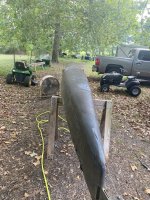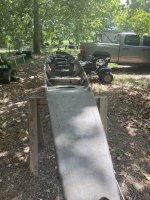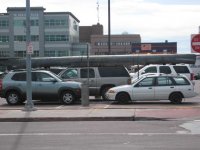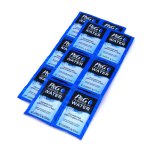I thought I would post this rebuild here even though this is not your typical tripping canoe. It is a racing canoe but, thought people could learn from how it was built and may be able to apply it to another build. If not delete away.
For the 2022 Texas Water Safari my paddling partner and I have not decided on which division we are competing in yet. Could be aluminum or tandem unlimited.
I picked up this “ Trimble” design boat off Craigslist for a “ get it out of my yard price”. Only a couple of these designs have been made and this one is from what I can tell 10-15 years old. It was made by Wade Binion from Texas for the Texas Water Safari. From the TWS there has been a design of boat that has been born that is a long, skinny, tough no frills boat. Wade is only one person out of a few that have made boats specifically for the TWS.
So this boat is in some what of rough shape. It was not paddle-able as it was. I patched it up and my daughter and I took it out last weekend. And paddled about a mile in it. Talk about tippy! There was no secondary stability in it. When you started to go over that was it you was getting wet. Lol. The first time setting in it we lasted about 10 seconds before we was swimming.
The bottom has been patched many times and needs to be patched again. I believe the layup is from the out side in is carbon-foam-Kevlar. I have patched one hole that I have found but I believe there is more that I am not seeing. So I am thinking about sanding and skimming the whole bottom with 4oz glass to seal every thing up. I know it will add weight but not sure how to seal it up.
The gunwales have been broken in multiple places. My thought is to cut them completely out and just replace with cedar covered with fiberglass?
For the 2022 Texas Water Safari my paddling partner and I have not decided on which division we are competing in yet. Could be aluminum or tandem unlimited.
I picked up this “ Trimble” design boat off Craigslist for a “ get it out of my yard price”. Only a couple of these designs have been made and this one is from what I can tell 10-15 years old. It was made by Wade Binion from Texas for the Texas Water Safari. From the TWS there has been a design of boat that has been born that is a long, skinny, tough no frills boat. Wade is only one person out of a few that have made boats specifically for the TWS.
So this boat is in some what of rough shape. It was not paddle-able as it was. I patched it up and my daughter and I took it out last weekend. And paddled about a mile in it. Talk about tippy! There was no secondary stability in it. When you started to go over that was it you was getting wet. Lol. The first time setting in it we lasted about 10 seconds before we was swimming.
The bottom has been patched many times and needs to be patched again. I believe the layup is from the out side in is carbon-foam-Kevlar. I have patched one hole that I have found but I believe there is more that I am not seeing. So I am thinking about sanding and skimming the whole bottom with 4oz glass to seal every thing up. I know it will add weight but not sure how to seal it up.
The gunwales have been broken in multiple places. My thought is to cut them completely out and just replace with cedar covered with fiberglass?
Attachments
Last edited:





